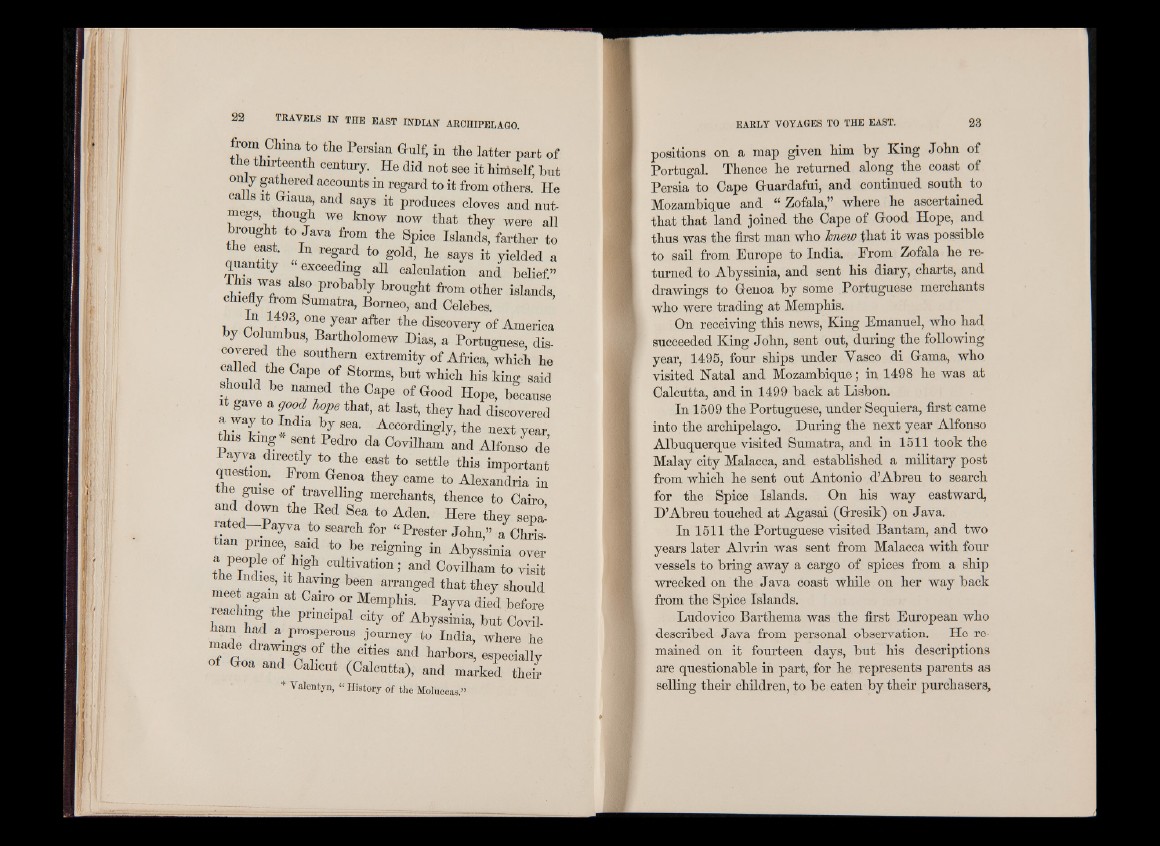
TRAVELS IN the EAST INDIAN ARCHIPELAGO.
from CMna to the Persian Gulf, in the latter part of
the thirteenth century. He did not see it hiniself, hut
only gathered accounts in regard to it from others. He
calls it Giaua, and says it produces cloves and nut-
megs though we know now that they were all
brought to Java from the Spice Islands, farther to
nnt +•+ * I n re^ard to he says it yielded a
quantity exceeding all calculation and belief”
This was also probably brought from other islands,
chiefly from Sumatra, Borneo, and Celebes.
In 1493, one year after the discovery of America
by Columbus, Bartholomew Dias, a Portuguese, disn
S0Utlleri1 extremitJ of Africa, which he
ailed the Cape of Storms, but which his king said
should be nmned the Cape of Good Hope, because
it gave a good Upe that, at last, they had discovered
t h i ^ S ? 1 \ AcGOrdbi^ J , the next year,
this king sent Pedro da Covilham and Alfonso de
Payva directly to the east to settle this important
question. R „m Genoa they ^ *
the guise of travelling merchants, thence to Cairo
S f c the Ked Sea to Adem Here they sep^
rated -Pay v a to search for “ Prester John,” a Chris-
tian prince, said to be reigning in Abyssinia over
a people of high cultivation; and Covilham to visit
the Indies, it having been arranged that they should
meet again at Cairo or Memphis. Payva died before
reaching the principal city of Abyssinia, but Covil-
am had a prosperous journey to India, where he
made drawings of the cities and harbors, especially
of Goa and Calicut (Calcutta), and marked theh
* Valentyn, “ History of the Moluccas.”
EARLY VOYAGES TO THE EAST. 23
positions on a map given him by King John of
Portugal. Thence he returned along the coast of
Persia to Cape Guardafui, and continued south to
Mozambique and u Zofala,” where he ascertained
that that land joined the Cape of Good Hope, and
thus was the first man who hnew that it was possible
to sail from Europe to India. From Zofala he returned
to Abyssinia, and sent his diary, charts, and
drawings to Genoa by some Portuguese merchants
who were trading at Memphis.
On receiving this news, King Emanuel, who had
succeeded King John, sent out, during the following
year, 1495, four ships under Vasco di Gama, who
visited Natal and Mozambique; in 1498 he was at
Calcutta, and in 1499 back at Lisbon.
In 1509 the Portuguese, under Sequiera, first came
into the archipelago. During the next year Alfonso
Albuquerque visited Sumatra, and in 1511 took the
Malay city Malacca, and established a military post
from which he sent out Antonio d’Abreu to search
for the Spice Islands. On his way eastward,
D’Abreu touched at Agasai (Gresik) on Java.
In 1511 the Portuguese visited Bantam, and two
years later Alvrin was sent from Malacca with four
vessels to bring away a cargo of spices from a ship
wrecked on the Java coast while on her way back
from the Spice Islands.
Ludovico Barthema was the first European who
described Java from personal observation. He remained
on it fourteen days, but his descriptions
are questionable in part, for he represents parents as
selling their children, to be eaten by their purchasers,